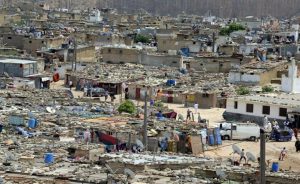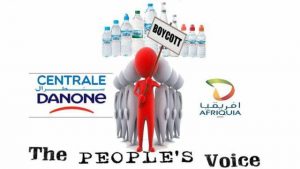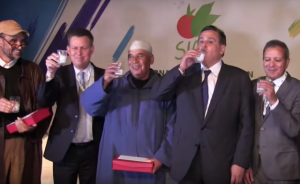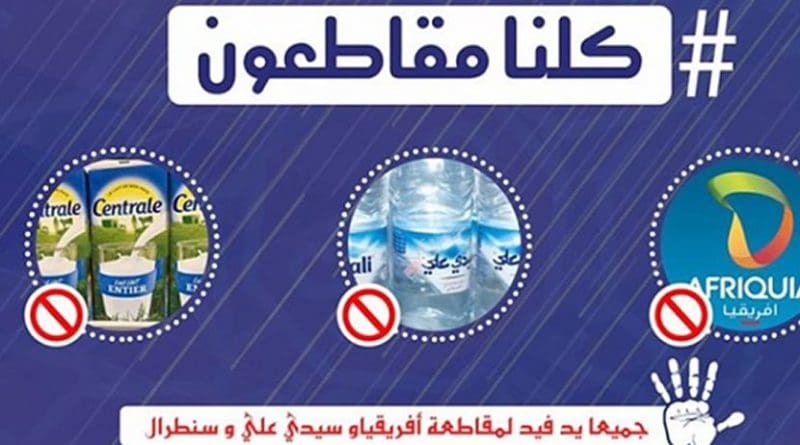The Rise Of Cyber Political Activism In Morocco – Analysis
After the Hirak i (uprising) of the Rif and that of Zagora and recent the one of Jerada, the needy of Morocco are resorting to another form of civilian resistance to fight those who, literally “own the country,” and, ultimately, hit them where it hurts the most: their businesses, pockets, gains and political standing.
The prices of consumer goods have been going up at an alarming rate in the last five years while the salaries have not increased a bit, in the least. As a result, the grassroots are the most hit in their tiny budgets. They are living in total squalor with no hope of improvement in sight for the time being.
The government is unable to scrap the remaining subsidies of such foodstuffs as: bread, oil, sugar and butane, for fear to face a popular uprising, is resorting to dirty tricks such as increasing prices of other products including petrol.
Two Moroccos, Two Different Speeds
In the past, right after independence, there were three social classes in the country: upper class, middle class and lower class.ii Today things have changed tremendously, there are only two classes left, miles apart from each other: the very rich made of the Makhzeniii families, military top brass, co-opted politicians and nouveaux riches, who made their wealth from corruption and embezzlement, and on the opposite side, the class of survivalists comprising the old middle class, the poor and very poor. As a matter of fact, since the beginning of the third millennium, Morocco has duly split into two Moroccos, cruising at different speeds:
The Morocco of the Golden Triangle, is made partly of the colonial Maroc Utile (Useful Morocco) which has extended in territory lately. It starts in Tangier and goes all the way to Laayoune, on a north to south axis, and from Casablanca to Fes, on a west to east axis, and beyond is rural hinterland and the Amazigh mountains where poverty reigns extreme: no decent infrastructure, very high illiteracy, no means of subsistence and rampant poverty and despair. In the past these regions used to survive thanks to employment in Europe, but since the mid 80s of the last century Europe closed its frontiers to migration and people of these regions have fallen into total squalor: no jobs for the adults and no future for their young siblings.
The Morocco of Despair is made of the hinterland and the periphery. It comprises the Amazigh/Berber mountains, the plateaus, the semi-arid and arid areas. In these areas people live off the land when the land is generous in humid years. In years of drought, they live off remittances of their families living in Europe. As for those who do not have this possibility they migrate to big cities with the elusive hope to find a job and survive and end up living in squalid conditions in slums in the belts of poverty. The successive governments since independence in 1956 have been unable to devise development programs to improve the lives of the people.
Official Morocco encourages foreign direct investment, but in the Golden Triangle only, not out of malice but only because of lack of adequate infrastructure in the periphery and this perpetuates the despair in this part of the country endlessly and makes the colonial Maroc Inutile (Useless Morocco) still useless, today, and forgotten when it comes to government action plans.
Moroccan Favelas iv
Actually, inside the Golden Triangle not everything is golden and is glistening with sparkling luster, when it comes to the life of all of the population. Almost every Moroccan city has its own belt of poverty made of people who migrated decades ago from the countryside, at the height of the drought cycle of the last century, with the hope to improve their economic lot, but instead they live in utter poverty and are easily recruited by Islamists to carry out terrorist attacks in Morocco, as was the case in Casablanca in 2003 and highlighted in the excellent film of Nabil Ayouch, “Horses of God”v or elsewhere and and join ISIS as cannon fodder.

Most big cities of Morocco of the Golden Triangle have their Favelas that mass produce pickpockets, drug peddlers, muggers, thieves, prostitutes, etc., as well as cheap labor, would be terrorists and Islamist fighters. In these Favelas the living conditions are terrible. The families are big and live in super crowded and unhealthy dwellings where sleeping is done in shifts due to the scarcity of rooms and beds, also. Nobody does die of hunger there yet because the main staple foods are still subsidized by the government, but if the latter gives in to the pressure of the World Bank, a popular revolution will ensue, no doubt.
In these poverty belts the common investment is café business and there are so many of these. Poor people often joke by saying that in the poor quarters “between a café and a café, there is a café,” meaning there is no serious infrastructure. These cafés are crowded all day by unemployed youth seeking escapist solutions to their predicament by chatting on their smart phones, watching soccer games on satellite television, smoking hashish or talking to their friends and most importantly waiting for Godot.
During the Arab Spring, the Moroccan social movement 20 Février denounced, in mammoth demonstrations, all the scourges of modern Morocco i.e. corruption, nepotism, embezzlement, patriarchy, tribalism and called on the monarchy, which is respected and seen as a symbol of stability, to become a true constitutional monarchy through the adoption of incremental democracy. Realizing the strength of this popular uprising, the monarch revamped the Constitution in 2011 and triggered the devolution of power process that was interrupted after the demise of the Arab Spring and the waning of the Islamist renaissance.
The ensuing general elections brought the Islamists of the Parti de la Justice et du Développement -PJD- to power with no real executive power in perspective because the Moroccan electoral system does not allow strong parties but parties that have to resort to coalition government arrangement to rule. Thus, the political scene is fragmented and makes of the monarchy the only credible power in presence and the only arbitration institution in the country.
Thus, the Islamists ruled for a full term of five years but were unable to download neither the new constitution nor their electoral platform and instead they had their share of power abuse and sex scandals like other secular parties. The Head of Government Benkirane spent the five years squabbling with the opposition parties instead of realizing the programs of his party’s electoral platform. As a result, the Islamists lost in popularity vis-à-vis the general public that espoused wholeheartedly their policies and objectives in the past.
However, in 2016, in spite of general public displeasure with their performance, yet they won more seats (125 of the 395 seats in the House of Representatives, a gain of 18 seats compared to the 2011 elections) in the general elections, but, on the other hand, lost the support of the Makhzen because they could not form a coalition government for almost six months due to the intransigence of the opposition. This was somewhat blamed on Benkirane’s pig-headedness, but in reality the establishment realizing that the strength of the Islamists is waning worldwide they wanted to impose their own man i.e. the rich businessman Akhennouch, a close friend of the monarch and his joker card to curtail Islamists’ influence and potency.
The rich of Morocco have always had access to the Makhzen and its privileges in return for blind allegiance and unquestionable support. Akhennouch and all the rich of the country are automatically allies of the monarchy and are locked into “scratch my back, I will scratch yours” equation with it.
The Electronic Hirak

The establishment does not seem to show any signs of wanting to solve the field Hiraks of the country peacefully, instead it is putting to trial all the militants and might even condemn some of them to the death penalty to preserve its hiba (loftiness) and state standing.
In the face of the intransigence of the establishment and as a further manifestation of the Arab Spring, the Moroccan poor people launched the electronic Hirak, boycotting the products of two super rich Moroccan rentiers and allies of the establishment: Akhennouch’s dairy products (Lait Centrale, Danone, etc. and gas at the pump of Afriquia) and related derivatives, as well as Meriem Bensaleh’s popular mineral water (Sidi Ali).
In this regard, Safae Kasraoui states forcefully in Morocco World News that:vi
“Baraka criticized the exorbitant prices of hydrocarbons, “which have reached a maximum that citizens can no longer stand.”
While several officials called the campaign a weak plot, Baraka said that “the important thing is not to know who is behind the campaign, but rather to understand the message conveyed” through the campaign.
The official said that the campaign reflects the suffering of citizens due to the high cost of living.
Several Moroccan celebrities have also expressed their support and solidarity with the online boycott campaign in protest of the rise in commodity prices, including Moroccan divas Asmae Lamnawar, Latifa Raafat, Saida Caharf, and Najat Aatabou.”
So far, the boycott using primarily Twitter, Facebook and WhatsApp is a total success because Akhennouch, hit hard in his wallet, came out publicly calling such an action an act of treason. Nevertheless, the grassroots angered by his attitude will certainly be tempted to include other products of his business in the popular boycott to punish him severely and bring down the prices of foodstuffs on the eve of Ramadan, a month of monster consumption.

The electronic Hirak will certainly strengthen the Islamists and their government led by al-Othmani, emasculated since its formation by the heavy weight politician Akhennouch. Parallel to that, the chances of the latter leading the next non-Islamist government are now nil and this will, undoubtedly, disappoint the establishment that was banking on him to reduce the influence of the Islamists especially after the miserable failure of the palace party Parti de l’Authenticité et de la Modernité led by Ilyas Omari. This electronic uprising might even in the long run bring down other politicians close to the palace.
Who Is Behind This Electronic Hirak?
This uprising calls itself, a spontaneous movement but in reality it is not. It is more likely that the PJD is behind it in the person of Benkirane who, holds a grudge against the establishment for booting him out the government. It is a well-known fact that one of the strengths of PJD is its electronic army known as al-kataib electroniya able to shape the public opinion through WhatsApp and the social media using the partaji ya mouwatin (share o citizen the message) successful scheme.
On this particular point, Zoubida Senoussi writes in Morocco World News:vii
“While some believe that this campaign comes as a direct result of denouncing the high cost of living–especially ahead of Ramadan, which witnesses a high peak consumption demands of dairy products–others opposed the boycott, asserting that this call is essentially a settlement of political accounts rather than an outburst of popular anger.
Moroccan media outlets, such as the Arabic daily Al Ahdath Al-Maghribiya, claimed that this campaign, which will run for over a month, is facade for a deeper political manipulation, orchestrated by what they have termed an “electronic army” close to Abdelilah Benkirane, former head of the Moroccan government and former Secretary General of the Justice and Development Party (PJD).”
But, all in all, the electronic boycott has gained, as of now, total independence from political parties and is becoming a political Tsunami rejecting peacefully and anonymously government agenda and establishment strategic plans.
Final word
The Arab Spring has turned sour and violent in Yemen, Syria and Libya lately and dissipated the dream of democracy of the majority of the Arabs. Will the Moroccan electronic uprising resuscitate the moribund Arab Spring and breathe life into it all over the region and offer the poor a new tool and means to make their voice heard?
Only time will show, for sure.
You can follow Professor Mohamed Chtatou on Twitter: @Ayurinu
Endnotes:
i. Hirak : uprising in Arabic language (from the Arabic root HRK meaning to move to contest.) It was used for the first time in the popular disobedience movement in the northern Moroccan city of Alhoceima (Rif region) and it has become since a standard term used to refer to any popular and peaceful contestation
ii. https://www.moroccoworldnews.com/2014/09/139649/spilling-the-beans-it-is-not-about-what-you-know-but-who-you-know/
iii. Makhzen: traditional and feudal-like system of governance in Morocco
iv. https://en.wikipedia.org/wiki/Favela
v. https://www.imdb.com/title/tt2369047/
vi. https://www.moroccoworldnews.com/2018/04/245371/boycott-reflects-suffering-of-citizens-nizar-baraka/
vii. https://www.moroccoworldnews.com/2018/04/245107/campaign-sidiali-commodity-morocco/

